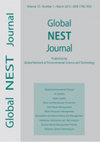Performance, yield and characteristics of bioflocculants (UPMBF13) produced by Bacillus subtilis UPMB13 during submerged and solid-state fermentation
IF 1.2
4区 环境科学与生态学
Q4 ENVIRONMENTAL SCIENCES
引用次数: 5
Abstract
This study compares the distinctive performance, yield and characteristics of bioflocculants (UPMBF13) derived from submerged (SmF) and solid-state fermentation (SSF) of Bacillus subtilis UPMB13. The bioflocculants were subjected to morphological characterization, functional groups determination, molecular weight measurement, protein content quantification and specific compound identification. The SmF and the SSF strategies yielded an average of 2.70 g l-1 and 1.25 g kg-1 of UPMBF13, respectively. The submerged UPMBF13 resulted in a clear suspension with visible flocs formation, while flocs from the SSF treatment were less apparent. Higher total proteinaceous contents of UPMBF13 from the SSF led to the inferiority in flocculating performances. The produced UPMBF13 consisted of hydroxyl, carboxyl, methoxyl and carbonyl functional groups which contributed to their flocculating abilities. The molecular weights of UPMBF13 were around 10-50 kDa, characterizing them into low-molecular weight bioflocculants. The submerged UPMBF13 were more fibrous in nature than the SSF, giving the submerged UPMBF13 the upper hand in flocculation. SmF was the best fermentation method yielding high performing bioflocculants at a faster rate by the utilization of non-elaborative techniques. SSF, on the other hand, was proven feasible but further improvements are needed.枯草芽孢杆菌(Bacillus subtilis UPMB13)深层和固态发酵生产生物絮凝剂(UPMBF13)的性能、产量和特性
本研究比较了枯草芽孢杆菌UPMB13深层发酵(SmF)和固态发酵(SSF)制备的生物絮凝剂(UPMBF13)的性能、产量和特性。对生物絮凝剂进行形态表征、官能团测定、分子量测定、蛋白质含量测定和特异性化合物鉴定。SmF和SSF策略的UPMBF13平均产量分别为2.70 g l-1和1.25 g kg-1。浸没的UPMBF13产生了清晰的悬浮液,并形成了可见的絮凝体,而SSF处理的絮凝体则不那么明显。SSF中UPMBF13的总蛋白含量较高,导致絮凝性能较差。所制得的UPMBF13由羟基、羧基、甲氧基和羰基官能团组成,这有助于它们的絮凝能力。UPMBF13分子量约为10 ~ 50 kDa,为低分子量生物絮凝剂。浸没后的UPMBF13比SSF具有更强的纤维性,这使得浸没后的UPMBF13在絮凝作用上占上风。SmF是利用非精细工艺生产高效絮凝剂的最佳发酵方法。另一方面,SSF已被证明是可行的,但需要进一步改进。
本文章由计算机程序翻译,如有差异,请以英文原文为准。
求助全文
约1分钟内获得全文
求助全文
来源期刊

Global Nest Journal
环境科学-环境科学
CiteScore
1.50
自引率
9.10%
发文量
100
审稿时长
>12 weeks
期刊介绍:
Global Network of Environmental Science and Technology Journal (Global NEST Journal) is a scientific source of information for professionals in a wide range of environmental disciplines. The Journal is published both in print and online.
Global NEST Journal constitutes an international effort of scientists, technologists, engineers and other interested groups involved in all scientific and technological aspects of the environment, as well, as in application techniques aiming at the development of sustainable solutions. Its main target is to support and assist the dissemination of information regarding the most contemporary methods for improving quality of life through the development and application of technologies and policies friendly to the environment
 求助内容:
求助内容: 应助结果提醒方式:
应助结果提醒方式:


